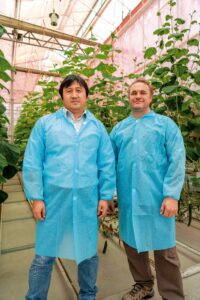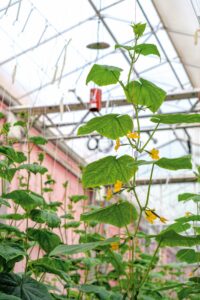Technicolour glasshouse offers energy saving productivity potential
Latest generation light-altering films being tested at a high-tech glasshouse in outer Sydney offer the potential to save protected cropping operations energy and boost productivity.
On the western outskirts of Sydney stands a glasshouse a little reminiscent of a cathedral window. Part of the facility glows pink in the afternoon sun, and part a pale blue.
The vibrant colours come from two special films applied to the glass, which are being trialled as part of a Hort Innovation levy-funded and CRC Future Food Systems supported project for their potential to reduce energy use and increase productivity in protected cropping.
Run out of the National Vegetable Protected Cropping Centre (NVPCC) at Western Sydney University’s Hawkesbury Institute for the Environment and School of Science, the four-and-a-half-year glasshouse films project follows two previous projects investigating novel glass and photovoltaic technologies in protected cropping which ran from 2016 to 2021.

“What this project’s trying to achieve is understanding how manipulating light diffusion and movement through films can affect plant growth,” said WSU’s Associate Professor Chris Cazzonelli, one of the chief investigators and plant molecular biologists leading the project.
“If we can understand how we can give the plants more light to sustain photosynthesis and how reducing some wavelengths within the spectrum can negatively affect photosynthesis and carbon production, we can then begin to manipulate those films to sustain plant growth and crop productivity, but at the same time tweak them in order to enhance our energy use efficiency as well.”
The project is trialling two different retrofitted films; a light-spectra-shifting agricultural film called LLEAF, and heat-blocking ‘smart glass’ called SG ULR-80.
Each film represents a different balancing act between reducing glasshouse cooling requirements, plant productivity and product quality.
For the films to be useful to industry, the trials need to quantify the benefits and trade-offs of each technology.
The potential benefits
Glasshouses use large amounts of energy to maintain a stable temperature, and even a small energy saving can yield big dividends for growers, according to project researcher and NVPCC Education and Training Director Professor Zhong-Hua Chen.
“The two biggest costs in the protected cropping industry are of course labour, followed by energy,” he said.
“So reducing even five per cent of energy requirements from protected cropping will save millions of dollars for growers.”
Professor Chen said some growers had already expressed an interest in the films, particularly the red LLEAF film.
“Growers want to see the actual cost-benefits,” says Professor Chen. “That’s why we have a team of researchers from the School of Business at WSU looking at the life cycle assessment, to look at how growers interested in purchasing those films for their greenhouses can get economical returns.”
A big plus for future commercialisation is the relatively low cost of the films, with any significant future adoption by industry driving costs even further down through economies of scale.
Another benefit is the ability to retrofit either film to existing protected cropping facilities. A future stage of the project will be exploring how the films perform in polytunnels.
Red film shows promise
The pink or red tinted LLEAF film is now in its third generation, and is showing some promise in enhancing photosynthesis, according to Professor Cazzonelli. The polycarbonate film has been lined on the roof and sides of two of the six bays in the NVPCC research glasshouse to test its effect on different vegetable crops.
“What it’s doing is providing more of the red wavelength of light,” he explained.
“It’s removing the green, translating it into more of a red, and it’s also diffusing the light so different parts of the crop canopy can get exposed to that light as it diffuses through.
“Essentially that combination of more red and more diffused light can enhance growth, and the red film appears to be enhancing photosynthesis to some degree.”
The energy saving balancing act

The SG ULR-80 film – given the more manageable ‘blue film’ moniker by those working on the project – has had some more challenges to overcome.
The blue film blocks parts of the ultraviolet and infrared spectrum of sunlight. Those parts of the spectrum are less useful to plants for photosynthesis, but are big contributors to heating in protected cropping, which then requires energy to cool.
Now in its second generation, the ‘blue’ film is noticeably less blue than the previous iteration. That visual difference reflects the work done on the product to balance its energy-saving properties with plant vigour.
“You’ve got to be careful when you’re changing the spectrum of light coming through in films, whether it’s appearing more red or more blue, because you can also alter the metabolism that’s occurring within the plant and the product quality,” said Professor Cazzonelli.
“With the first generation of blue film, there was a bit of a reduction in overall light transmission and it stole a bit of the blue and red wavelengths of light.”
“In its second generation, we’ve re-engineered it to bring back some of that red and blue and a little bit of the ultraviolet and infrared, while still hoping that we can reduce the light energy that comes in that causes heating within the glasshouse.”
“Unfortunately this film is reducing photosynthesis to some degree, and also affecting photo protection.”
The blue film’s trial results are still providing useful information, however, on the relationship between light capture and photosynthesis, carbon production and photo protection, which is the mechanism plants use to protect themselves on sunny days.
“We’re trying to understand how these processes are coordinated, with the end goal of essentially keeping the plants on steroids, keeping them at maximum growth whether it’s a cloudy day or sunny day,” said Professor Cazzonelli.
‘Chameleon glass’ the end goal
Understanding how plants respond to different light spectra and intensities offers the potential to develop future films that respond actively to changing light conditions to maximise plant growth.
“Hopefully down the track that will lead to the engineering of films that could be almost like a chameleon, where they can change their spectrum and characteristics depending on if it’s a bright sunny day or a cloudy day,” said Professor Cazzonelli. “That’s the end goal.”
“Ultimately we’ve got to get a fine balance from the film between the energy use efficiency, and whether you’re seeking a gain in productivity or the nutritional value of the crop.”
Watch our interview on YouTube
Glasshouse films is funded by Hort Innovation using the vegetable industry research and development levy and contributions from the Australian Government. Project number: VG21006
This article first appeared in Australian Grower Winter 2024 magazine

